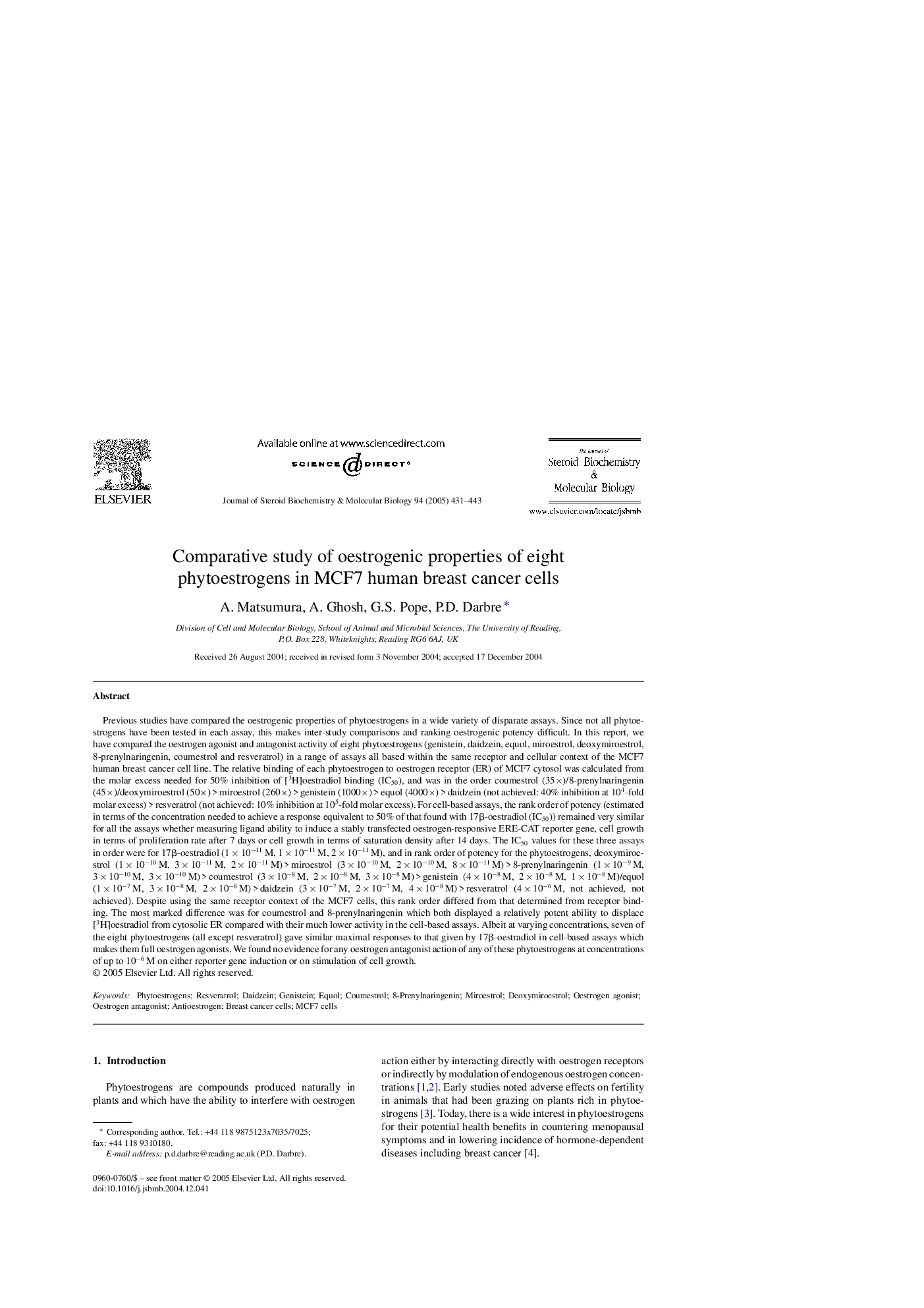| کد مقاله | کد نشریه | سال انتشار | مقاله انگلیسی | نسخه تمام متن |
|---|---|---|---|---|
| 9892148 | 1541102 | 2005 | 13 صفحه PDF | دانلود رایگان |
عنوان انگلیسی مقاله ISI
Comparative study of oestrogenic properties of eight phytoestrogens in MCF7 human breast cancer cells
دانلود مقاله + سفارش ترجمه
دانلود مقاله ISI انگلیسی
رایگان برای ایرانیان
کلمات کلیدی
موضوعات مرتبط
علوم زیستی و بیوفناوری
بیوشیمی، ژنتیک و زیست شناسی مولکولی
زیست شیمی
پیش نمایش صفحه اول مقاله

چکیده انگلیسی
Previous studies have compared the oestrogenic properties of phytoestrogens in a wide variety of disparate assays. Since not all phytoestrogens have been tested in each assay, this makes inter-study comparisons and ranking oestrogenic potency difficult. In this report, we have compared the oestrogen agonist and antagonist activity of eight phytoestrogens (genistein, daidzein, equol, miroestrol, deoxymiroestrol, 8-prenylnaringenin, coumestrol and resveratrol) in a range of assays all based within the same receptor and cellular context of the MCF7 human breast cancer cell line. The relative binding of each phytoestrogen to oestrogen receptor (ER) of MCF7 cytosol was calculated from the molar excess needed for 50% inhibition of [3H]oestradiol binding (IC50), and was in the order coumestrol (35Ã)/8-prenylnaringenin (45Ã)/deoxymiroestrol (50Ã) > miroestrol (260Ã) > genistein (1000Ã) > equol (4000Ã) > daidzein (not achieved: 40% inhibition at 104-fold molar excess) > resveratrol (not achieved: 10% inhibition at 105-fold molar excess). For cell-based assays, the rank order of potency (estimated in terms of the concentration needed to achieve a response equivalent to 50% of that found with 17β-oestradiol (IC50)) remained very similar for all the assays whether measuring ligand ability to induce a stably transfected oestrogen-responsive ERE-CAT reporter gene, cell growth in terms of proliferation rate after 7 days or cell growth in terms of saturation density after 14 days. The IC50 values for these three assays in order were for 17β-oestradiol (1 Ã 10â11 M, 1 Ã 10â11 M, 2 Ã 10â11 M), and in rank order of potency for the phytoestrogens, deoxymiroestrol (1 Ã 10â10 M, 3 Ã 10â11 M, 2 Ã 10â11 M) > miroestrol (3 Ã 10â10 M, 2 Ã 10â10 M, 8 Ã 10â11 M) > 8-prenylnaringenin (1 Ã 10â9 M, 3 Ã 10â10 M, 3 Ã 10â10 M) > coumestrol (3 Ã 10â8 M, 2 Ã 10â8 M, 3 Ã 10â8 M) > genistein (4 Ã 10â8 M, 2 Ã 10â8 M, 1 Ã 10â8 M)/equol (1 Ã 10â7 M, 3 Ã 10â8 M, 2 Ã 10â8 M) > daidzein (3 Ã 10â7 M, 2 Ã 10â7 M, 4 Ã 10â8 M) > resveratrol (4 Ã 10â6 M, not achieved, not achieved). Despite using the same receptor context of the MCF7 cells, this rank order differed from that determined from receptor binding. The most marked difference was for coumestrol and 8-prenylnaringenin which both displayed a relatively potent ability to displace [3H]oestradiol from cytosolic ER compared with their much lower activity in the cell-based assays. Albeit at varying concentrations, seven of the eight phytoestrogens (all except resveratrol) gave similar maximal responses to that given by 17β-oestradiol in cell-based assays which makes them full oestrogen agonists. We found no evidence for any oestrogen antagonist action of any of these phytoestrogens at concentrations of up to 10â6 M on either reporter gene induction or on stimulation of cell growth.
ناشر
Database: Elsevier - ScienceDirect (ساینس دایرکت)
Journal: The Journal of Steroid Biochemistry and Molecular Biology - Volume 94, Issue 5, April 2005, Pages 431-443
Journal: The Journal of Steroid Biochemistry and Molecular Biology - Volume 94, Issue 5, April 2005, Pages 431-443
نویسندگان
A. Matsumura, A. Ghosh, G.S. Pope, P.D. Darbre,